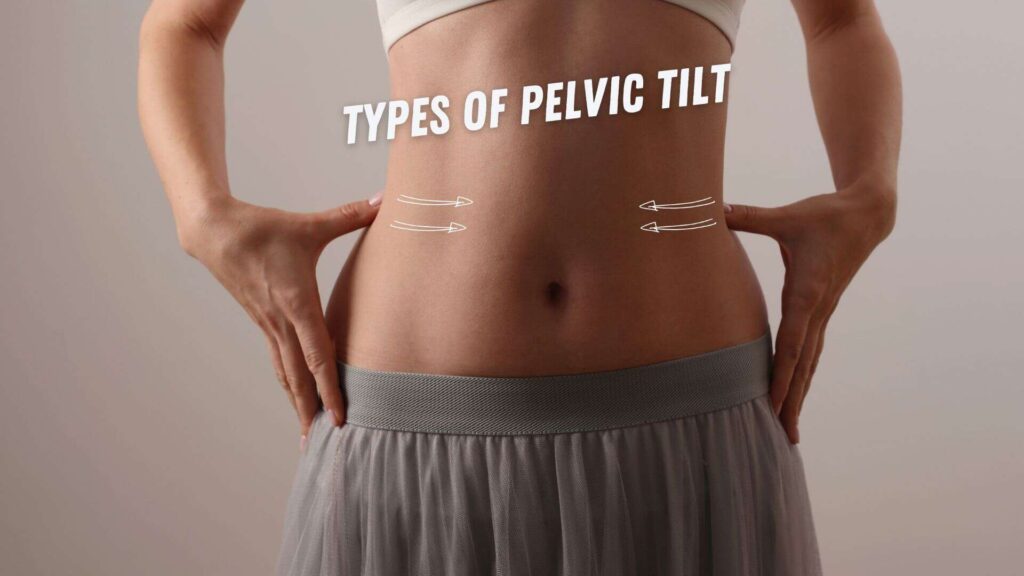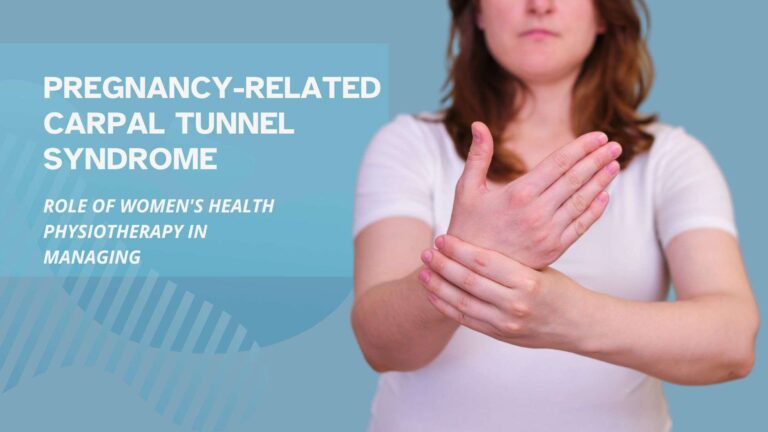Understanding Pelvic Tilt, Dynamics, Misconceptions And The Role of Pelvic Health Physiotherapy
The human body is a complex and interconnected system, and one area that often goes unnoticed but plays a crucial role in overall stability is the pelvis. Pelvic tilt, an often-overlooked aspect of posture, can significantly affect musculoskeletal health. In this blog, we will explore pelvic tilt in its various forms, some common misconceptions and the paramount role pelvic floor physiotherapy plays in its treatment.
Understanding pelvic tilt
Pelvic tilt refers to the orientation of the pelvis to the thighs and the rest of the body. It refers to an abnormal tilting or rotation of the pelvis, which can lead to various musculoskeletal issues. The pelvis is a foundation for the spine and supports the body’s weight during movement. When the pelvis is misaligned, it affects the position and function of surrounding muscles, joints, and ligaments.
Dynamics of pelvic tilt
The pelvis is a complex structure that plays a crucial role in our body’s movement and stability. The pelvic tilt is a natural and necessary component of the spine’s alignment, allowing for optimal distribution of weight and balance. It is the point of convergence for several muscle groups, including the abdominals, glutes, and hip flexors. When these muscles are imbalanced, it can lead to a shift in the pelvis, known as an excessive pelvic tilt.

There are three main types of pelvic tilt:
Anterior pelvic tilt
Anterior pelvic tilt occurs when the front of the pelvis drops down while the back rises. This leads to increased curvature in the lower back (lordosis) and a protruding abdomen. Individuals with anterior pelvic tilt may experience lower back pain, tight hip flexors, weak glutes, and postural imbalances.
Posterior pelvic tilt
A backward rotation of the pelvis characterizes the posterior pelvic tilt. In this position, there is reduced lumbar curvature (flat lower back) and a tucked-in appearance of the buttocks. It can cause muscle imbalances such as weak abdominal muscles, tight hamstrings, and discomfort in the hips or buttocks.
Lateral pelvic tilt
The lateral pelvic tilt is characterized by one side of the pelvis being higher than the other.
Uneven leg lengths, muscle imbalances, or scoliosis can contribute to lateral tilt.
Symptoms of pelvic tilt problems
General symptoms of excessive pelvic tilt can include
- General pain in the lower back.
- Increased pain during or after walking.
- Pain after standing still for a period of time.
- Aches and pains while lying down.
- Pain that radiates down to the hips or buttocks.

Causes of exaggerated pelvic tilt
Understanding the causes behind improper pelvic tilt is essential for effective treatment. Several factors contribute to this condition:
Muscular imbalances:
- Weak abdominal muscles: Insufficient strength in the abdominal muscles, especially the rectus abdominis and transverse abdominis, can contribute to an anterior pelvic tilt.
- Tight hip flexors: Prolonged sitting or activities that involve repetitive hip flexion can lead to tight hip flexor muscles (iliopsoas), pulling the pelvis into an anterior tilt.
- Weak gluteal muscles: Weakness in the gluteal muscles, particularly the gluteus maximus, can disrupt the balance between the front and back of the pelvis, contributing to pelvic tilt.
Poor posture:
- Sedentary lifestyle: Extended periods of sitting, common in desk jobs and sedentary lifestyles, can contribute to weakened core muscles and an increased risk of posterior pelvic tilt.
- Improper standing posture: Habitual poor posture, such as standing with excessive lower back arching, can contribute to excessive pelvic tilt.
Injury or trauma:
- Traumatic Injuries: Injuries to the pelvis or surrounding structures can lead to muscle imbalances and affect pelvic tilt.
- Surgery: Surgical procedures involving the pelvic region or spine can alter the biomechanics of the area, potentially influencing pelvic tilt.
Structural issues:
- Leg Length Discrepancy: A significant difference in the length of the legs can result in an uneven pelvis, leading to lateral pelvic tilt.
- Scoliosis: A sideways curvature of the spine can impact the alignment of the pelvis, contributing to lateral pelvic tilt.
- Spinal Misalignment: Issues with the spine, such as misalignments or vertebral abnormalities, can affect pelvic positioning.
Pregnancy and childbirth:
- Pregnancy: Hormonal changes and the growing uterus can affect pelvic alignment during pregnancy, leading to temporary changes in pelvic tilt.
- Childbirth: The process of childbirth can impact the pelvic floor muscles and contribute to changes in pelvic tilt.
Genetic factors:
- Hereditary factors: Genetic predispositions may contribute to structural abnormalities or conditions that affect pelvic alignment.
Obesity:
- Excess Weight: Carrying excess body weight, especially around the abdominal area, can increase stress on the spine and pelvis, influencing the pelvic tilt.
It’s important to note that these causes are often interconnected, and an individual may experience pelvic tilt due to a combination of factors.

Common misconceptions about pelvic tilt
Pelvic tilt is a term that describes the orientation of the pelvis in relation to the rest of the body. However, there are also several misconceptions about pelvic tilt that can lead to confusion and improper treatment. These can include
Misconception 1: Anterior pelvic tilt is always bad.
Anterior pelvic tilt is often considered a problem that needs to be corrected. However, it is essential to understand that no inherently good or impaired movement exists. Pelvic tilt is a natural movement that a healthy body should be able to perform. It is only when the tilt becomes excessive or causes pain and discomfort that it may need to be addressed through physiotherapy.
Misconception 2: Sitting causes anterior pelvic tilt
Many people believe that sitting for long periods leads to anterior pelvic tilt. However, research has shown that sitting actually results in posterior pelvic tilt, not anterior. This misconception may lead to incorrect treatment approaches and a misunderstanding of the underlying causes of pelvic tilt issues.
Misconception 3: Pelvic tilt is solely a pelvic issue
Pelvic tilt is often thought of as an isolated issue with the pelvis. However, it is essential to recognize that pelvic tilt is an entire body issue, and addressing only the pelvic muscles may not be sufficient. A comprehensive approach that considers the entire body is necessary for effective treatment.
Misconception 4: Pelvic tilt is only a concern for women
While it’s true that certain conditions related to pelvic tilt, such as pelvic organ prolapse, are more common in women, pelvic tilt itself is not gender-specific. Both men and women can experience anterior, posterior, or lateral pelvic tilt issues. It’s important for everyone, regardless of gender, to understand pelvic tilt and seek appropriate treatment if it’s causing discomfort or pain.
Misconception 5: All pelvic tilt is abnormal.
Some degree of pelvic tilt is normal and necessary for movement and function. Problems arise when the tilt is excessive or when it leads to discomfort or pain. It’s important to remember that everyone’s body is different, and what is considered a “normal” degree of pelvic tilt can vary from person to person.
Physiotherapy can help address these misconceptions by providing education and individualized treatment plans.

The role of pelvic health physiotherapy
Pelvic health physiotherapy emerged as a specialized field designed to address issues related to the pelvic region. Physiotherapy can help address pelvic tilt issues by focusing on the underlying causes and incorporating individualized treatment plans. Here’s a closer look at how pelvic floor physiotherapy plays a pivotal role in understanding and managing pelvic tilt conditions.
Comprehensive assessment:
Pelvic health physiotherapists conduct thorough assessments to identify pelvic tilt’s specific type and severity, considering muscle strength, flexibility, and overall posture.
A comprehensive assessment helps identify the type and severity of pelvic tilt. Range of motion tests, postural analysis, muscle strength assessments, and functional movement testings are among the tools used by physiotherapists for accurate diagnosis.
Manual therapy techniques:
Physiotherapists may employ various hands-on techniques to alleviate pain, improve joint mobility, and correct muscular imbalances associated with pelvic tilt. These techniques include soft tissue mobilization, joint mobilization, myofascial release, and stretching exercises.
Tailored treatment plans:
Customized exercise programs are designed to target muscle imbalances and weaknesses contributing to excess pelvic tilt. This treatment plan often focuses on core muscles, hip flexors, and glutes to enhance stability and alignment.
Addressing pelvic floor dysfunction:
Excessive pelvic tilt is often associated with pelvic floor dysfunction, and pelvic health physiotherapy can effectively address issues such as muscle imbalances, incontinence issues, pain, or weakness in the pelvic floor muscles.
Functional movement training
Physiotherapists can teach patients how to perform daily activities like sitting, lifting, and standing with proper body mechanics and pelvic alignment, reducing the risk of pain and injury.
Educational empowerment:
Physiotherapists can provide education about pelvic tilt, helping to dispel misconceptions and provide a better understanding of the issue.
Lifestyle modifications
Certain lifestyle modifications can help improve pelvic tilt issues, such as making proper ergonomic adjustments, performing regular movements, stretching, and weight management.
- Regular movement breaks and stretching routines throughout the day help prevent muscle imbalances and allow the pelvis to maintain proper alignment.
- Simple activities like walking, gentle yoga, or pilates can improve pelvic health.
- Maintaining a healthy weight reduces excess stress on the pelvis and musculoskeletal system.
- A well-balanced diet and regular exercise promote optimal bone density, muscle strength, and overall well-being.
Optimizing Posture and Health
An abnormal pelvic tilt can negatively impact posture, increasing the risk of injury and can cause pain and discomfort. In the field of musculoskeletal health, understanding and addressing pelvic tilt conditions is paramount.
By seeking the expertise of a pelvic health physiotherapist, individuals can take proactive steps to enhance their posture and alleviate discomfort. By understanding the dynamics of pelvic tilt and embracing the insights of pelvic health physiotherapy, individuals can be on a path toward a more aligned, comfortable, and healthier life.

Cynthia Pathipati – Registered Physiotherapist
Cynthia Pathipati completed her bachelor’s in physiotherapy and is a qualified Registered Physiotherapist in good standing with the College of Physiotherapists of BC with more than 15 yrs of experience. She has Post-Graduate Credentials and Certifications as well as extensive knowledge experience in treating pelvic floor, orthopedic, neurological, vestibular and pain conditions.







